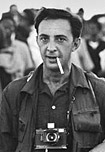

Photographer James Karales
Biography adapted from The New York Times.
American, b. 1930, d. 2002.
James Karales was a photojournalist who's best known body of work included coverage of the 60s civil rights struggle. His 1965 picture of determined marchers outlined against a lowering sky became a pictorial anthem of the civil rights movement. He died in 2002 at the age of 71. The cause was cancer, his wife, Monica, said.
A resident of Croton-on-Hudson, N.Y., Mr. Karales was a staff photographer for LOOK from 1960 until that magazine closed in 1972. He documented pivotal events of that tumultuous era, notably the civil rights movement and the Vietnam War. While many photojournalists trained their cameras on the brutally confrontational, Mr. Karales often took quietly sober pictures that, the critic Vince Aletti noted in The Village Voice, had 'the weight of history and the grace of art.' To study Mr. Karales's iconic picture of the march in Alabama from Selma to Montgomery is to appreciate the power and poetry that he packed into a seemingly casual picture. Leading the march, and setting its tone, are two young men and a young woman, all in shirts and dark pants and striding in step. There is a scattering of Stars and Stripes. But as if hinting of what is to come, the sky is a huge mass of dark clouds.
Mr. Karales was born on July 15, 1930, in Canton, Ohio, to Greek immigrants and planned to be an electrical engineer when he enrolled at Ohio University. That changed the day he saw what his roommate, a photography major, did in the darkroom, Mrs. Karales said. He switched his major to photography. With a Bachelor of Fine Arts degree in 1955, he went to the Magnum photo agency in New York and became the darkroom assistant to the master photographer W. Eugene Smith. Mr. Karales was housed and fed by the Smith family and worked without pay, Mrs. Karales said. His two-year stint left a permanent mark on him. He became a first-rate printer, producing velvety shades of gray and black. Like Smith, he underscored the human dimension in even his most harrowing pictures. And like Smith, he immersed himself in the subjects of his photo essays.
After his time with Smith, Mr. Karales documented life in Rendville, Ohio, a mining town that was one of the few integrated communities in America in the late 1950's. He showed his picture essay to Edward Steichen, director of photography at the Museum of Modern Art in New York, who bought two of the images for that museum's collection. Helen Gee gave him his first solo exhibition in 1958, showing his Rendville pictures at her Greenwich Village gallery, Limelight. That same essay drew the attention of LOOK's photography editor and landed Mr. Karales a job there. After Look closed, Mr. Karales became a freelance photographer.
Unlike other noted photojournalists of his era, Mr. Karales's name and work – other than his picture of the marchers – remain little known, and no book of his work has been published. Mr. Karales was modest and unaggressive to a fault, said Howard Greenberg, who gave Mr. Karales his first major exhibition in his New York gallery in June 1999.
The James Karales Collection of photographs and papers were acquired by the Duke University Rare Book, Manuscript, and Special Collections Library in 2004. The Duke Karales Collection Web site is here.